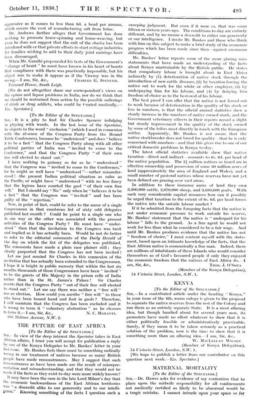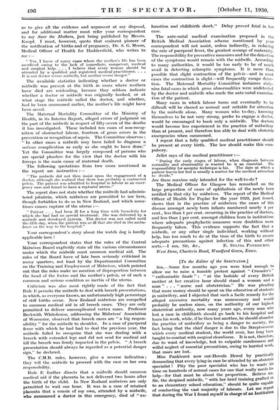MATERNAL MORTALITY
[To the Editor of the SPECTATOR.]
SIR,—Dr. Hawes asks for evidence of my contention that to place upon the midwife responsibility for all confinements not medically certified as likely to be abnormal would be a tragic mistake. I cannot intrude upon your space so fa,r,
as to give all the evidence and argument at my disposal, and for additional matter must refer your correspondent to toy Save the Mothers, just being published by Messrs. Knopf. I must, however, quote that eminent pioneer of the notification of births and of pregnancy, Dr. S. G. Moore, Medical Officer of Health for Huddersfield, who writes to
1RIC :—
" Yes, I know of many cases where the mother's life has been sacrificed owing to the lack of immediate, competent, medical and surgical help. . . . I believe that every woman should be attended by a qualified and registered medical practitioner. . . . It is not doctor versus midwife, but mother versus danger."
The available statistics indicating whether a doctor or midwife was present at the birth in cases where mothers have died are misleading, because they seldom indicate whether a doctor or midwife was originally booked, or at what stage the midwife called the doctor, and whether, had he been summoned earlier, the mother's life might have been saved.
The Maternal Mortality Committee of the Ministry of Health, in its Interim Report, alleged errors of judgment on the part of the midwife in respect of fifty-seven of the deaths it has investigated. These included ten cases of non-recog- nition of obstructed labour, fourteen of gross errors in the prevention or recognition of sepsis. The Committee observes : In other eases a midwife may have failed to diagnose a serious complication as early as she ought to have done." Yet the Committee was largely composed of persons who are special pleaders for the view that the doctor with his forceps is the main cause of maternal death.
The following quotations from two cases mentioned in the report are instructive :—
"The midwife did not then insist upon the engagement of a doctor, although she realized that there was probably a contracted pelvis. The patient was admitted to hospital in labour as an emer- gency case and found to have a ruptured uterus."
The report does not state whether the midwife had adminis- tered pituitrin, which midwives are permitted to use here, though forbidden to do so in New Zealand, and which some- times causes rupture of the uterus :—
" Patient . . . had been ill for a long time with bronchitis for which she had had no special treatment. She was delivered by a midwife and developed pyrexia. The doctor was not called until the fifth day, when the patient was so ill that she died in the ambu- lance on the way to the hospital."
Your correspondent's story about the watch dog is hardly applicable here !
Your correspondent states that the rules of the Central Midwives Board explicitly state all the various circumstances under which the midwife must summon medical aid. The rules of the Board have of late been seriously criticized in many quarters, not least by the Departmental Committee on the Training and Employment of Midwives, which pointed out that the rules make no mention of disproportion between the head of the foetus and the mother's pelvis, or of such a common and serious condition as inertia of the uterus.
Criticism was also most rightly made of the fact that Rule E permits the midwife to deal with breech presentations, in which, as everyone knows, an unfortunately high percentage of still births occur. New Zealand midwives are compelled to summon medical aid in all breech eases. They are only permitted to deliver uncomplicated vertex cases. Professor Beckwith Whitehouse, addressing the Midwives' Association of Worcester, observed that breech eases are "a big respon- sibility " for the midwife to shoulder. In a case of puerperal fever with which he had had to deal the previous year, the midwife failed to recognize that she was dealing with a breech with extended legs and did not send for medical aid till the breech was firmly impacted in the pelvis. "A breech presentation should always be regarded as a potential danger sign," he declared.
The C.M.B. rules, however, give a reverse indication ; they tell the midwife to proceed with the case on her own responsibility.
Rule E further directs that a midwife should summon medical aid if the placenta be not delivered two hours after the birth of the child. In New Zealand midwives are only Permitted to wait one hour. It was in a case of retained placenta that a cousin of my own, attended by a midwife, Who summoned a doctor in this emergency, died of " ex-
haustion and childbirth shock." Delay proved fatal in her case.
The ante-natal medical examination proposed in the British Medical Association scheme mentioned by your correspondent will not assist, unless indirectly, in reducing the rate of puerperal fever, the greatest scourge of maternity. The responsibility for preventive measures and for the detection of the symptoms would remain with the midwife. According to many authorities, it would be too early to be of much avail in detecting eclamptic symptoms. It is more than possible that slight contraction of the pelvis—and in most cases the contraction is slight—will frequently escape detec- tion. The Maternal Mortality Conunittee instances sixty- nine fatal cases in which gross abnormalities were undetected by the doctor and midwife who made the ante-natal examina- tion of the patient.
Many eases in which labour turns out eventually to be difficult will be classed as normal and suitable for attention by the midwife alone. Many women who to-day, knowing themselves to be not very strong, prefer to engage a doctor, would be encouraged to book only a midwife. The doctors would become less experienced in the practice of midwifery than at present, and therefore less able to deal with obstetric emergencies when summoned.
I repeat that a fully qualified medical practitioner should he present at every birth. The law should make this com- pulsory.
Jellet says of the medical practitioner :—
" During the early stages of labour, when diagnosis between normality and abnormality is wanted he is an essential. The responsibility for aseeptio technique is his. The date at which a patient leaves her bed is usually a matter for the medical attendant to decide."
Are these maxims only intended for the well-to-do ?
The Medical Officer for Glasgow has remarked on the large proportion of cases of ophthalmia of the newly born notified in that city by midwives. The report of the Medical Officer of Health for Poplar for the year 1929, just issued, shows that in the practice of midwives the cases of this disease amongst newly born infants numbered nearly 4 per cent., less than 1 per cent, occurring in the practice of doctors, and less than I per cent, amongst children born in institutions where adequate prophylactic measures were doubtless more frequently taken. This evidence supports the fact that a midwife, or any other single individual, working without help, has too much to do at the time of the birth to ensure adequate precautions against infection of this and other









































 Previous page
Previous page